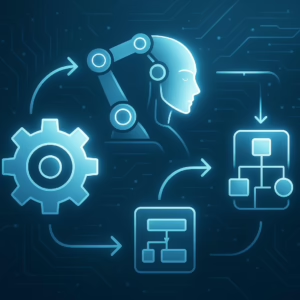Learn How to Use AI for Work: Boosting Efficiency Through Automation and Streamlined Workflow
In today’s fast-paced professional landscape, learning how to use AI for work is becoming essential for individuals and businesses aiming to stay competitive and efficient. Artificial Intelligence (AI) is no longer just a futuristic concept; it’s now a practical tool that can revolutionize the way tasks are managed, especially by leveraging automation and optimizing workflow. Integrating AI into your daily professional routine can lead to significant time savings, improved accuracy, and enhanced productivity.
Understanding AI and Its Role in Automation
 AI refers to the capability of machines to perform tasks that typically require human intelligence, such as decision-making, speech recognition, problem-solving, and learning. When it comes to work processes, AI’s most valuable attribute is its ability to automate repetitive, time-consuming tasks. Automation powered by AI means that mundane activities such as data entry, scheduling, or customer support can be handled swiftly and with minimal human intervention.
AI refers to the capability of machines to perform tasks that typically require human intelligence, such as decision-making, speech recognition, problem-solving, and learning. When it comes to work processes, AI’s most valuable attribute is its ability to automate repetitive, time-consuming tasks. Automation powered by AI means that mundane activities such as data entry, scheduling, or customer support can be handled swiftly and with minimal human intervention.
For example, many companies use AI-driven chatbots to provide instant customer service, freeing human agents to focus on more complex inquiries. Similarly, in industries like finance or marketing, AI can automatically analyze large volumes of data and generate reports, reducing the burden on employees.
Enhancing Workflow with AI
Workflow refers to the sequence of processes through which work passes from initiation to completion. A well-structured workflow is vital for efficiency and coordination in any organization. By integrating AI into workflow systems, companies can streamline operations, reduce bottlenecks, and improve overall project management.
AI tools can automatically assign tasks based on employee availability and skill sets, prioritize urgent jobs, and even forecast project timelines by analyzing historical data. This level of insight helps managers make more informed decisions and keeps teams aligned on goals.
Additionally, AI can assist in monitoring ongoing workflows, flagging any inconsistencies or delays proactively. This means potential issues can be addressed before they escalate, ensuring deadlines are met and quality standards are maintained.
Practical Ways to Use AI for Work Automation
1. Automate Routine Administrative Tasks
Many administrative tasks consume valuable time but do not necessarily require human judgment. AI-powered tools can automate email sorting, appointment scheduling, invoice processing, and document management. For instance, AI calendars can recommend optimal meeting times by analyzing participants’ availability, while intelligent scanning software can extract necessary information from receipts or contracts.
2. Implement Intelligent Data Analysis
Data is abundant in every sector, but turning raw data into actionable insights can be challenging. AI algorithms can analyze complex data sets quickly and accurately, identifying patterns and trends that humans might miss. This makes strategic planning and decision-making more data-driven and informed.
3. Leverage AI for Customer Relations
Customer interactions often require personalized and timely responses. AI customer service platforms can handle inquiries 24/7, provide instant answers to frequently asked questions, and even recognize customer sentiment to escalate critical issues to human agents. This improves customer satisfaction without increasing operational costs.
4. Optimize Marketing Campaigns
In marketing, AI helps optimize campaigns by analyzing consumer behavior, predicting market trends, and automatically adjusting ad placements for maximum engagement. AI tools can segment audiences and personalize content to increase conversion rates, making workflows in marketing departments smarter and more effective.
Getting Started: How to Incorporate AI into Your Workflow
To make the most of AI’s automation capabilities, start small and identify repetitive tasks that consume time but don’t require complex problem-solving. Explore AI software solutions or platforms tailored to your industry or role. Many companies offer AI integration services that can customize tools to fit specific workflow processes.
Train your team on how to interact with AI systems and manage exceptions when automation cannot fully replace human judgment. Encouraging feedback from users helps improve AI tools and adapt workflows continuously.
Addressing Challenges When Using AI at Work
Adopting AI can come with challenges such as initial setup costs, data privacy concerns, and resistance to change among employees. It is essential to communicate clear benefits and provide adequate training to reduce apprehension. Moreover, always ensure AI systems comply with data protection regulations to maintain trust and security.
The Future of Work with AI
AI-driven automation and optimized workflow solutions are transforming workplaces by allowing employees to focus on creative, strategic, and interpersonal aspects of their roles. As AI technology continues to evolve, understanding how to use AI for work will become a critical skill in almost every profession.
By embracing AI, companies not only increase efficiency but also create more engaging and fulfilling work environments where human potential is amplified rather than replaced.
Learning how to use AI for work effectively means harnessing the power of automation to eliminate repetitive tasks and structuring workflow systems that maximize productivity. Whether you are a small business owner or part of a large enterprise, integrating AI smartly can unlock new levels of performance and innovation. Start exploring AI applications today to transform your work experience and future-proof your career.



